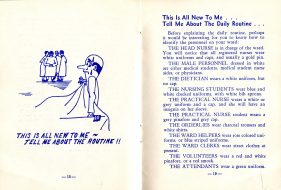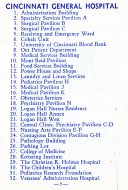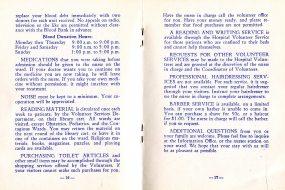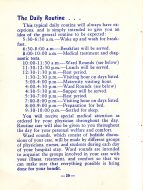The following post was written by Winkler Center assistant archivist, Nina Herzog. All images courtesy of the Henry R. Winkler Center for the History of the Health Professions
Without a doubt, checking into and staying at hospitals is a lot different today than it was over a half century ago. Computerized check-ins, televisions in rooms and bans on smoking, etc. have all improved the patient experience. The images below were taken from an informational booklet given to patients at the Cincinnati General Hospital (CGH) in 1958.
The instructive pamphlet titled, “Well Here I Am,” provides the incoming patient with information on subjects ranging from check in, dining hours, and visitor information to hospital maps, directions, and much more.
Page 13 (below ) informs the patient on smoking, telephones and keeping ‘suitably clothed’. Patient rooms had no telephones; all calls were routed through nursing stations.
Page 16 advises on how to obtain reading material and the next page discusses hair care service. Interestingly, a barber was provided, presumably for male patients, yet anyone desiring a hairdresser had to contact their personal stylist.
Why did women have to contact their own stylists? One guess is that in this day and age a woman never left home without looking, at the very least, presentable; this included perfectly coiffured hair. It’s also possible that women’s hairstyles were more intricate than a man’s cut and therefore women desired someone who was accustomed to working with their hair. Also, apparently stylists were allowed into a patient’s room to complete a haircut and a style
During this period nurses, orderlies, and other hospital staff wore different uniforms. Below is an overview of who wore what uniform so patients could identify who it was coming into their room. In today’s hospital stay, one experiences a number of doctors, nurses and other health professionals all dressed in scrubs. Is there still a way in contemporary hospitals of identifying different personnel?
Visiting hours certainly are more relaxed now, though departure times have not changed greatly since the late 1950s. Patients are permitted to have family and visitors in the room throughout the day, but in most instances still need to depart at 8:00 pm. Finally, page 20 (below) shows a patient a general daily routine. Note the maternity ward has only one visiting hour.
Seeing the changes made over the last 59 years, one wonders how hospital stays will evolve over the next 50 years?






